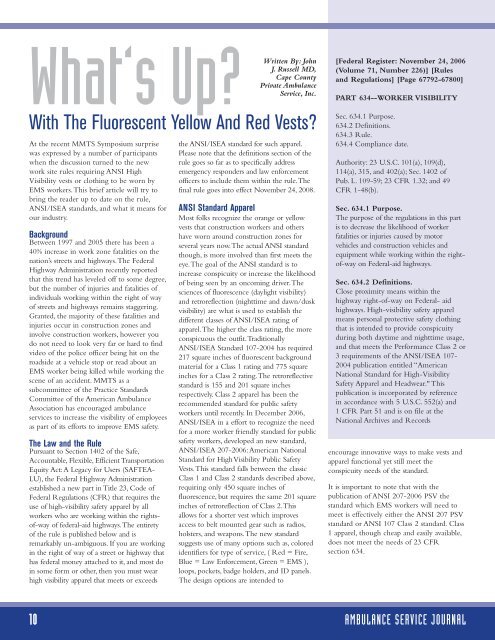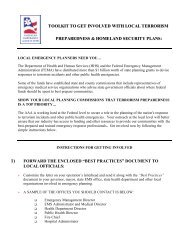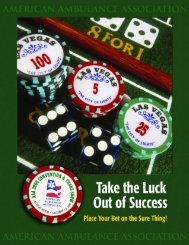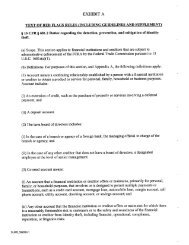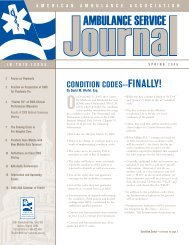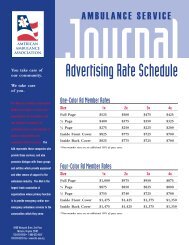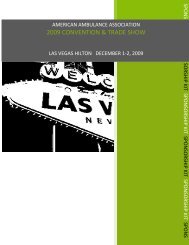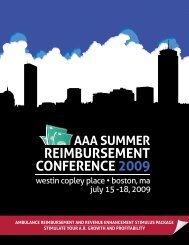Summer 2007 - American Ambulance Association
Summer 2007 - American Ambulance Association
Summer 2007 - American Ambulance Association
Create successful ePaper yourself
Turn your PDF publications into a flip-book with our unique Google optimized e-Paper software.
What’s Up?<br />
At the recent MMTS Symposium surprise<br />
was expressed by a number of participants<br />
when the discussion turned to the new<br />
work site rules requiring ANSI High<br />
Visibility vests or clothing to be worn by<br />
EMS workers.This brief article will try to<br />
bring the reader up to date on the rule,<br />
ANSI/ISEA standards, and what it means for<br />
our industry.<br />
Background<br />
Between 1997 and 2005 there has been a<br />
40% increase in work zone fatalities on the<br />
nation’s streets and highways.The Federal<br />
Highway Administration recently reported<br />
that this trend has leveled off to some degree,<br />
but the number of injuries and fatalities of<br />
individuals working within the right of way<br />
of streets and highways remains staggering.<br />
Granted, the majority of these fatalities and<br />
injuries occur in construction zones and<br />
involve construction workers, however you<br />
do not need to look very far or hard to find<br />
video of the police officer being hit on the<br />
roadside at a vehicle stop or read about an<br />
EMS worker being killed while working the<br />
scene of an accident. MMTS as a<br />
subcommittee of the Practice Standards<br />
Committee of the <strong>American</strong> <strong>Ambulance</strong><br />
<strong>Association</strong> has encouraged ambulance<br />
services to increase the visibility of employees<br />
as part of its efforts to improve EMS safety.<br />
The Law and the Rule<br />
Pursuant to Section 1402 of the Safe,<br />
Accountable, Flexible, Efficient Transportation<br />
Equity Act:A Legacy for Users (SAFTEA-<br />
LU), the Federal Highway Administration<br />
established a new part in Title 23, Code of<br />
Federal Regulations (CFR) that requires the<br />
use of high-visibility safety apparel by all<br />
workers who are working within the rightsof-way<br />
of federal-aid highways.The entirety<br />
of the rule is published below and is<br />
remarkably un-ambiguous. If you are working<br />
in the right of way of a street or highway that<br />
has federal money attached to it, and most do<br />
in some form or other, then you must wear<br />
high visibility apparel that meets or exceeds<br />
Written By: John<br />
J. Russell MD,<br />
Cape County<br />
Private <strong>Ambulance</strong><br />
Service, Inc.<br />
With The Fluorescent Yellow And Red Vests?<br />
the ANSI/ISEA standard for such apparel.<br />
Please note that the definitions section of the<br />
rule goes so far as to specifically address<br />
emergency responders and law enforcement<br />
officers to include them within the rule.The<br />
final rule goes into effect November 24, 2008.<br />
ANSI Standard Apparel<br />
Most folks recognize the orange or yellow<br />
vests that construction workers and others<br />
have worn around construction zones for<br />
several years now.The actual ANSI standard<br />
though, is more involved than first meets the<br />
eye.The goal of the ANSI standard is to<br />
increase conspicuity or increase the likelihood<br />
of being seen by an oncoming driver.The<br />
sciences of fluorescence (daylight visibility)<br />
and retroreflection (nighttime and dawn/dusk<br />
visibility) are what is used to establish the<br />
different classes of ANSI/ISEA rating of<br />
apparel.The higher the class rating, the more<br />
conspicuous the outfit.Traditionally<br />
ANSI/ISEA Standard 107-2004 has required<br />
217 square inches of fluorescent background<br />
material for a Class 1 rating and 775 square<br />
inches for a Class 2 rating.The retroreflective<br />
standard is 155 and 201 square inches<br />
respectively. Class 2 apparel has been the<br />
recommended standard for public safety<br />
workers until recently. In December 2006,<br />
ANSI/ISEA in a effort to recognize the need<br />
for a more worker friendly standard for public<br />
safety workers, developed an new standard,<br />
ANSI/ISEA 207-2006:<strong>American</strong> National<br />
Standard for High Visibility Public Safety<br />
Vests.This standard falls between the classic<br />
Class 1 and Class 2 standards described above,<br />
requiring only 450 square inches of<br />
fluorescence, but requires the same 201 square<br />
inches of retroreflection of Class 2.This<br />
allows for a shorter vest which improves<br />
access to belt mounted gear such as radios,<br />
holsters, and weapons.The new standard<br />
suggests use of many options such as, colored<br />
identifiers for type of service, ( Red = Fire,<br />
Blue = Law Enforcement, Green = EMS ),<br />
loops, pockets, badge holders, and ID panels.<br />
The design options are intended to<br />
[Federal Register: November 24, 2006<br />
(Volume 71, Number 226)] [Rules<br />
and Regulations] [Page 67792-67800]<br />
PART 634--WORKER VISIBILITY<br />
Sec. 634.1 Purpose.<br />
634.2 Definitions.<br />
634.3 Rule.<br />
634.4 Compliance date.<br />
Authority: 23 U.S.C. 101(a), 109(d),<br />
114(a), 315, and 402(a); Sec. 1402 of<br />
Pub. L. 109-59; 23 CFR 1.32; and 49<br />
CFR 1-48(b).<br />
Sec. 634.1 Purpose.<br />
The purpose of the regulations in this part<br />
is to decrease the likelihood of worker<br />
fatalities or injuries caused by motor<br />
vehicles and construction vehicles and<br />
equipment while working within the rightof-way<br />
on Federal-aid highways.<br />
Sec. 634.2 Definitions.<br />
Close proximity means within the<br />
highway right-of-way on Federal- aid<br />
highways. High-visibility safety apparel<br />
means personal protective safety clothing<br />
that is intended to provide conspicuity<br />
during both daytime and nighttime usage,<br />
and that meets the Performance Class 2 or<br />
3 requirements of the ANSI/ISEA 107-<br />
2004 publication entitled “<strong>American</strong><br />
National Standard for High-Visibility<br />
Safety Apparel and Headwear.'' This<br />
publication is incorporated by reference<br />
in accordance with 5 U.S.C. 552(a) and<br />
1 CFR Part 51 and is on file at the<br />
National Archives and Records<br />
encourage innovative ways to make vests and<br />
apparel functional yet still meet the<br />
conspicuity needs of the standard.<br />
It is important to note that with the<br />
publication of ANSI 207-2006 PSV the<br />
standard which EMS workers will need to<br />
meet is effectively either the ANSI 207 PSV<br />
standard or ANSI 107 Class 2 standard. Class<br />
1 apparel, though cheap and easily available,<br />
does not meet the needs of 23 CFR<br />
section 634.<br />
10<br />
AMBULANCE SERVICE JOURNAL


